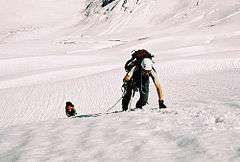Third Man factor

The Third Man factor or Third Man syndrome refers to the reported situations where an unseen presence such as a spirit provides comfort or support during traumatic experiences. Sir Ernest Shackleton in his book South, described his belief that an incorporeal being joined him and two others during the final leg of their journey. Shackleton wrote, "during that long and racking march of thirty-six hours over the unnamed mountains and glaciers of South Georgia, it seemed to me often that we were four, not three."[1] His admission resulted in other survivors of extreme hardship coming forward and sharing similar experiences.
In recent years well-known adventurers like climber Reinhold Messner and polar explorers Peter Hillary and Ann Bancroft have reported the experience. One study of cases involving adventurers reported that the largest group involved climbers, with solo sailors and shipwreck survivors being the second most common group, followed by polar explorers.[2] Some journalists have related this to the concept of a guardian angel or imaginary friend. Scientific explanations consider this a coping mechanism or an example of bicameralism.[3] The concept was popularized by a book by John G. Geiger The Third Man Factor, that documents scores of examples.
Modern psychologists have used the 'third man factor' to treat victims of trauma. The 'cultivated inner character' lends imagined support and comfort.[4]
Literary references
Who is the third who walks always beside you?
When I count, there are only you and I together
But when I look ahead up the white road
There is always another one walking beside you
Gliding wrapt in a brown mantle, hooded
I do not know whether a man or a woman
— But who is that on the other side of you?
Lines 359 through 365 of T. S. Eliot's modernist poem The Waste Land (1922) were inspired by Shackleton's experience, as stated by the author in the notes included with the work.
In Geraldine McCaughrean's young adult fiction novel, The White Darkness (2005), the teenage heroine, Sym, joins a doomed Antarctic expedition. Abandoned and lost, she is guided to safety by a "third man", her imaginary friend, Captain Lawrence Oates.
In Larry McMurtry's Western novel Lonesome Dove (1985), Pea Eye, after surviving an Indian attack with Gus, makes a trek back to Call and has an experience of a "ghost" or "spirit" that guides him during his walk.
Thomas Pynchon's novel Against the Day (2006) makes reference to the experience.
In Max Brooks' novel World War Z, Colonel Christina Eliopolis crash lands in the midst of zombie infested territory but is able to survive and be picked up with the assistance of a Sky Watcher codenamed "Mets Fan" who is later revealed to be a figment of her imagination. She maintains belief that Mets is a real person.
Resources
- Geiger, John (2009). The Third Man Factor. Toronto: Viking Canada. ISBN 0-14-301751-9.
- "The Current for January 27, 2009 - Part 3: Third Man Factor". CBC Radio: The Current. January 27, 2009.
- Messner, Reinhold (September 13, 2009). "Guardian Angels Or The 'Third Man Factor'?". NPR. Retrieved 26 January 2010.
- Literature DOI: 10.1016/j.cub.2014.09.049 - Neurological and robot-controlled induction of an apparition - describes how the Third man factor, is produced in experiments as ´feelings of presence´(FoP) - with normal persons.
References
- ↑ Shackleton, Ernest Henry (1914). South: The Endurance Expedition. Frank Hurley, Fergus Fleming. Penguin Classics. p. 204. ISBN 0-14-243779-4.
- ↑ Suedfeld, Peter and Geiger, John, (2008) “The sensed presence as a coping resource in extreme environments” In: Ellens, J. Harold (ed.), Miracles God, Science, and Psychology in the Paranormal (Vol.3) Praeger. ISBN 0-275-99722-7
- ↑ White, Nancy J. (January 30, 2009). "Third man theory of otherworldly encounters". The Star. Retrieved 2009-02-05.
- ↑ An adventurer's angel, Australian Geographic, 15 September 2012
External links
- Chalmers, Sarah (3 July 2009). "The Third Man Factor: How those in dire peril have felt a sudden presence at their side, inspiring them to survive". Mail Online. Retrieved 6 July 2009.
- John Geiger's Website